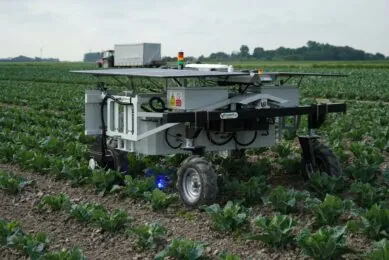E-robotiller to combat soil compaction emission-free

The first prototype of the Dutch E-robotiller field robot for autonomous tillage is nearing completion. This autumn the lightweight fuel cell driven robot is to be in operation.
With the so-called E-robotiller, a group of innovative arable farmers from the Netherlands, united under the name HWodKa, wants to put a lightweight hydrogen-powered field robot for seed and seedbed preparation on the market.
To this end, the group received a government grant almost a year ago. The concept has since also won second prize in Future Farming’s Best Field Robot Concept award. For the development and construction of the robot they work together with Dutch company Reedyk Hydrauliek.
Text continues underneath video
33% weight can be converted into tractive force
According to HWodKa, a rule of thumb (perhaps somewhat outdated by now) is that you can convert one-third of the weight of a tractor into tractive force. In a tractor/implement combination, the weight transferred by the implement must also be included. The relationship between the weight and the ability to exert tractive force is reflected in practice.
In various ways weight is added to tractors in order to be able to exert more pulling power with the same power. Think of front and wheel weights and simply heavier tractors.
Soil compaction
Pulled implements require a relatively heavy tractor. However, making a tractor heavier to perform a tillage operation is not a smart move because a heavy tractor requires more power to overcome rolling resistance and it results in greater soil compaction. In addition, it requires more power to then eliminate that compaction with tillage operations.
Trailed tillage implements are often rather primitive implements that have to rely mainly on their capacity. Instead of pulling a tine through the ground, you can also drive it. This allows the movement of the tine in the ground to provide propulsion.
Rotary tiller
A rotary tiller is a well-known example of this principle. Such a powered implement requires a relatively lightweight tractor. However, accelerating (moving quickly) soil requires a lot of power and causes extra wear. Therefore driven implements do not excel in working speed.
However, the intensity of cultivation is more controllable and can be adapted to variations within the fields. There is less chance of blockage by crop residues and soil, so the implement can be built more compactly. At the same time, driven implements and stones are poorly compatible.
Text continues underneath image

Speed is less important for robots
With field robots, working speed is a less important issue because man-hours are not part of the tillage cost. This offers new opportunities for autonomous, (electrically) driven and also lighter tillage implements that cause substantially less soil compaction, require little power (energy) and are easily controllable. Like the HWodKa E-rRobotiller with its six support rollers that, in addition to tilling the soil, also provide traction, steering and navigation.
The intensity of tillage is controlled, among other things, by a difference in speed between the front and rear rollers and by shifting weight and thus the center of gravity in the direction of travel. Steering, as with many tracked vehicles, is done by means of a difference in speed between the left and right rollers.
E-robotiller in various configurations
The E-robotiller is intended, in various configurations, for full-field mechanical weed control, seed and seed bed preparation, stubble operations including the sowing of green manure crops and the destruction and tilling cover crops under, among other things. The E-robotiller is expected to see the light of day this fall.
The future will show whether the robot leads to a new course in tillage techniques. One in which energy plays a much smaller role and weight and soil compaction, expensive tires or tracks play no role at all.
Join 17,000+ subscribers
Subscribe to our newsletter to stay updated about all the need-to-know content in the agricultural sector, two times a week.



